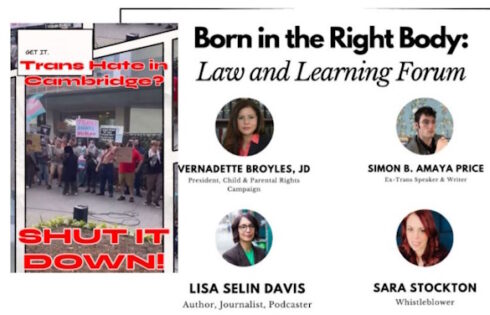
‘All of higher ed really needs to be paying attention to this in the classroom and people in employment need to be dealing with this, because I think this conversation is getting louder, not quieter.’ – Dot Brauer, director of University of Vermont’s LGBTQA Center
Harvard University, American University, the University of Vermont and the University of Wisconsin-Milwaukee are moving away from a binary gender system by allowing students to classify themselves as something other than male or female and encouraging the campus community to call such students by their gender-preferred pronouns.
The distinction of male and female, accompanied by the respective pronouns he and she, has been expanded on these campuses with a nebulous vocabulary of invented pronouns. As fluid as the “gender continuum” they represent, these pronouns represent those individuals who feel that they are “genderqueer,” or do not fall into the categories of male or female.
American University’s Center for Diversity and Inclusion offers a pronoun guide which states “the practice of asking individuals what pronouns they use for themselves should be done in an effort to respect the diversity of gender identities beyond man and woman.”
The university lists four pronouns often used by the transgender community: “ze,” “e,” “per” and “they,” clarifying that “ze” may take two different object forms – “hir” and “zir.” “Ze” may have different spellings, such as “zie,” “sie,” “xie,” and “xe.”
The guide includes the following mandate: “Never argue with or question a person’s gender identity or pronouns.”
The University of Vermont has also validated a third gender with its use of gender-neutral pronouns. The New York Times reports that this result follows nearly a decade of lobbying, a campus-wide campaign from the school’s transgender community, and $80,000 in staff time for the creation of new software.
Dot Brauer, director of UVM’s LGBTQA Center, helped shape the conversation surrounding the adoption of gender-neutral pronouns.
“All of higher ed really needs to be paying attention to this in the classroom and people in employment need to be dealing with this, because I think this conversation is getting louder, not quieter,” Brauer told The College Fix in a phone interview.
“It’s really about inclusion…there really are people in the world who don’t feel completely comfortable being boxed into femininity or masculinity exclusively,” they added. “What we are experiencing now is that there is a growing conversation about those experiences and people want the opportunity to been seen, addressed and recognized as who they are.”
Interestingly, Brauer noted the move toward gender-neutral pronouns actually began outside of universities.
“There’s diversity of opinion everywhere you go. There are more and more corporations out there that are deciding that they want to be on the progressive edge because they want to attract the most talented employees. Corporations have actually been ahead of universities on this front,” they said.
A public institution, the University of Vermont, offers “neutral” as a gender option when collecting student information. It also allows students to forge a new identity, complete with a new first name and specific pronoun with which they would like to be referred.
“Identifying as genderqueer is an opportunity to self-invent, unburdened from social expectations about dress and behavior,” the Times reported.
Since the policy changed in 2009, 1,891 students at the University of Vermont have requested non-binary pronouns. Most commonly, students have asked – despite the grammatical error – to be referenced as “they” or “them” rather than by pronouns that specify male or female.
Harvard University recently followed suit, adding this year an option for students manually write in their preferred gender pronouns during registration, such as “ze, hir, hirs” and “they, them, theirs.”
The University of Wisconsin-Milwaukee offers a “Student Preferred Name option” that allows students to go by a name that matches their preferred gender. A guide on the UW-Milwaukee website explains how to use the various pronouns that go along with the program:
They, them, theirs (Xena ate their food because they were hungry.) This is a pretty common gender-neutral pronoun…. And yes, it can in fact be used in the singular.
Ze, hir (Xena ate hir food because ze was hungry.) Ze is pronounced like “zee” can also be spelled zie or xe, and replaces she/he/they. Hir is pronounced like “here” and replaces her/hers/him/his/they/theirs.
Just my name please! (Xena ate Xena’s food because Xena was hungry) Some people prefer not to use pronouns at all, using their name as a pronoun instead.
Never, ever refer to a person as “it” or “he-she” (unless they specifically ask you to.) These are offensive slurs used against trans and gender non-conforming individuals.
Similarly, last year at San Diego State University its officials approved a new policy that gave transgender students the opportunity to have their preferred gender-identity officially recognized.
Other schools encourage the use of gender neutral pronouns, and general sensitivity surrounding pronoun usage, despite not directly amending their practices.
The University of Tennessee-Knoxville’s Office of Diversity and Inclusion made headlines recently after it encouraged students and professors to be cognizant of student wants, suggesting pronouns such as “ze, xe, xem, xyr, zirs and hirs.” The suggestion was met with resistance and more recently the guidelines were taken down from the university’s website.
But the movement toward an embrace of gender-neutral pronouns has expanded outside of university life to the sphere of social media. Facebook offers 50 pronoun options from which users can choose to specify their gender. Options include “pangender,” “bigender,” “androgynous,” “agender,” “cisgender,” “neutrois,” “gender questioning,” or even “custom” if those 50 do not satisfy.
The shift toward acceptance of gender-neutral pronouns has been mirrored by the promotion of gender-neutral bathrooms and dorm rooms.
More than 150 schools in the United States have now created gender-neutral bathrooms, according to the Stonewall Center of UMass Amherst. Additionally, 197 universities have gender-neutral housing policies, which let students share a dorm room with a member of the same gender, opposite gender, or with someone whose gender they may not be able to ascertain.
Meanwhile, students and academics wade through the confusing list of emerging pronouns and their rules.
“Writing a paper on someone who uses more than one set of pronouns… Help?” stated one recent post in the “Ask Academia” subReddit, to which came a myriad of different advice:
I’d use a combination of 1 and 3: alternate between pronouns, but make a footnote about the reason for it so that the reader is aware. But try to use the surname as often as possible to avoid confusion and be really clear about who “he/she” refers to (if you’re also mentioning other people).
I’d either use a neutral pronoun such as “xe” or pick one and stick to it. I think alternating is a bad idea in terms of clarity.
Use “they”. Or at least that is something I’d prefer to read, if I were to read your book. Alternating between he and she sounds like something extremely confusing for a reader (even if the person actually does or did it in life).
RELATED: Calif. students now given six ‘gender identity’ choices on college admissions applications
Like The College Fix on Facebook / Follow us on Twitter
IMAGE: Shutterstock





Please join the conversation about our stories on Facebook, Twitter, Instagram, Reddit, MeWe, Rumble, Gab, Minds and Gettr.